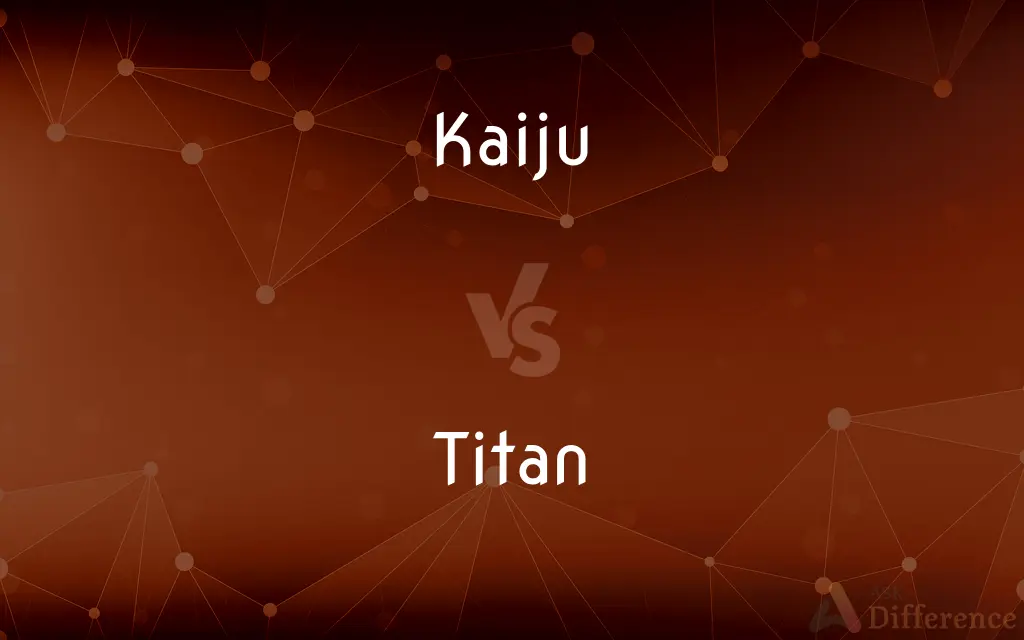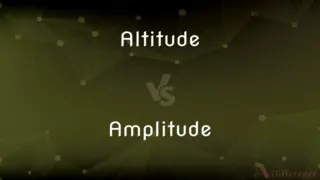Kaiju vs. Titan — What's the Difference?
Edited by Tayyaba Rehman — By Maham Liaqat — Updated on April 21, 2024
Kaiju are giant monsters from Japanese media, often depicted as destructive forces; Titans, in Greek mythology, are deities predating the Olympian gods, embodying primal aspects of the world.

Difference Between Kaiju and Titan
Table of Contents
ADVERTISEMENT
Key Differences
Kaiju originate from Japanese cinema, notably seen in films like "Godzilla," where they are often portrayed as gigantic, destructive monsters arising from environmental disturbances. Whereas Titans come from Greek mythology, depicted as powerful gods who ruled during the legendary Golden Age and were later overthrown by the Olympian gods.
In terms of symbolism, Kaiju are frequently used as metaphors for natural disasters or human-induced calamities, reflecting cultural fears and societal issues. On the other hand, Titans symbolize elemental forces and pre-civilizational chaos, representing the raw, untamed aspects of nature and existence.
The narrative roles of Kaiju and Titans also differ significantly. Kaiju are usually antagonists or antiheroes causing massive destruction, often leading to humanity's efforts to combat or coexist with them. Conversely, Titans are often seen as the original rulers of the cosmos who are overthrown, adding a layer of tragedy to their lore as they are usurped by the younger Olympians.
Visually and thematically, Kaiju are depicted with a variety of appearances, sometimes resembling dinosaurs, other creatures, or wholly original designs, emphasizing their role as anomalies disrupting the natural order. In contrast, Titans are typically portrayed in a more humanoid form, grandiose and majestic, underscoring their role as primordial deities.
In popular culture, Kaiju have a significant presence in movies, television, and graphic novels, predominantly in Japanese media but also increasingly in international productions. Titans, while rooted in ancient Greek mythology, are frequently explored in literature, art, and film, influencing a wide range of narratives in Western culture.
ADVERTISEMENT
Comparison Chart
Origin
Japanese cinema
Greek mythology
Symbolism
Natural disasters, human calamities
Elemental forces, primordial chaos
Narrative Role
Antagonists, disruptors of order
Original rulers, overthrown by Olympians
Visual Representation
Various monstrous forms, often large and destructive
Humanoid, majestic, embodying natural elements
Cultural Presence
Predominantly in Japanese and international media
Extensively in Western literature, art, and media
Compare with Definitions
Kaiju
Usually arising due to human error or environmental disturbances.
Hedorah, the smog monster kaiju, warns of pollution.
Titan
Often depicted as tragic figures of lost power.
Titans are often mourned in myths for their downfall.
Kaiju
Often depicted as destructive forces of nature.
Mothra, a kaiju, represents both destruction and rebirth.
Titan
Primordial gods from Greek mythology.
Cronus, a Titan, ruled before the Olympians.
Kaiju
Giant monsters typically appearing in Japanese media.
Godzilla, a famous kaiju, symbolizes nuclear dangers.
Titan
Overthrown by their Olympian children in mythological tales.
Zeus led the rebellion against the Titans.
Kaiju
Can be either antagonistic or sympathetic characters.
Some kaiju, like Gamera, are portrayed as protectors of Earth.
Titan
Influence modern interpretations of power and rule.
The term titanic refers to something large and powerful, derived from the Titans.
Kaiju
Central figures in movies involving monster battles.
Kaiju fight scenes are central to films like Pacific Rim.
Titan
Represent fundamental aspects of the world.
Oceanus, the Titan of the ocean, embodies the sea.
Kaiju
Kaiju (Japanese: 怪獣, Hepburn: Kaijū, lit. 'Strange Beast') is a Japanese genre of films and television featuring giant monsters. The term kaiju can also refer to the giant monsters themselves, which are usually depicted attacking major cities and battling either the military or other monsters.
Titan
Greek Mythology One of a family of giants, the children of Uranus and Gaea, who sought to rule heaven and were overthrown and supplanted by the family of Zeus.
Kaiju
A giant monster, particularly of the kind found in Japanese science fiction films, like Godzilla or Gamera.
Titan
Titan One of prodigious size, strength, or achievement
"the twin titans of the beverage industry" (David Barboza).
Titan
The largest satellite of Saturn and the second largest satellite in the solar system.
Titan
Something or someone of very large stature, greatness, or godliness.
Titan
Titanic.
The Titan physical difficulties of his enterprise.
Titan
A person of exceptional importance and reputation
Titan
(Greek mythology) any of the primordial giant gods who ruled the Earth until overthrown by Zeus; the Titans were offspring of Uranus (Heaven) and Gaea (Earth)
Titan
The largest of the satellites of Saturn; has a hazy nitrogen atmosphere
Common Curiosities
What role do Titans play in Greek mythology?
Titans are often seen as the original deities of the cosmos, overthrown by the next generation of gods.
What is the primary origin of Kaiju?
Kaiju primarily originate from mid-20th-century Japanese cinema.
Can Kaiju be seen as sympathetic figures?
Yes, some kaiju are depicted sympathetically, often misunderstood creatures reacting to human actions.
How are Titans depicted in terms of power?
Titans are depicted as immensely powerful, embodying primal world aspects.
How do Kaiju reflect cultural fears?
Kaiju often metaphorically represent various societal fears, such as nuclear destruction and environmental disasters.
What differentiates Kaiju from typical monsters?
Kaiju are distinct in their massive scale and the thematic depth they represent.
How do Kaiju and Titans compare in terms of visual representation?
Kaiju vary widely in form, often monstrous, while Titans are more uniform, typically humanoid and majestic.
What is the typical portrayal of Titans in literature?
Titans are usually portrayed as grandiose, sometimes tragic figures representing the old order.
Are there any notable films featuring Titans?
Films like "Clash of the Titans" and "Wrath of the Titans" explore Titan themes.
How are Titans used in modern storytelling?
Titans often symbolize large, foundational forces in stories, influencing themes of power and tradition.
How have Kaiju influenced international media?
Kaiju have influenced a variety of media internationally, inspiring films, shows, and comics beyond Japan.
Do Kaiju have any symbolic roles beyond destruction?
Beyond destruction, kaiju can symbolize rebirth, protection, or retribution against human follies.
What is the impact of Kaiju on Japanese culture?
Kaiju have a significant cultural impact in Japan, symbolizing post-war fears and societal challenges.
Why were the Titans overthrown in mythology?
The Titans were overthrown as part of a mythological narrative of succession and rebellion by the Olympian gods.
What is the cultural significance of Titans in Western culture?
Titans have a deep cultural significance in Western culture, often used to explore themes of power, downfall, and the natural order.
Share Your Discovery

Previous Comparison
Altitude vs. Amplitude
Next Comparison
Maltreat vs. MistreatAuthor Spotlight
Written by
Maham LiaqatEdited by
Tayyaba RehmanTayyaba Rehman is a distinguished writer, currently serving as a primary contributor to askdifference.com. As a researcher in semantics and etymology, Tayyaba's passion for the complexity of languages and their distinctions has found a perfect home on the platform. Tayyaba delves into the intricacies of language, distinguishing between commonly confused words and phrases, thereby providing clarity for readers worldwide.
















































